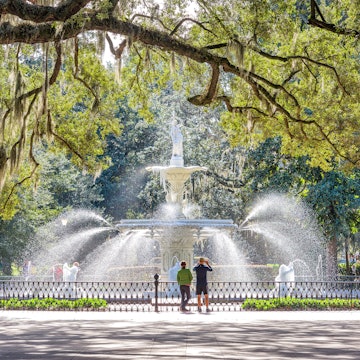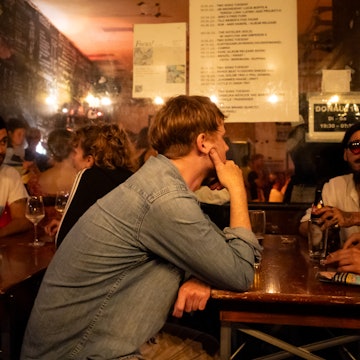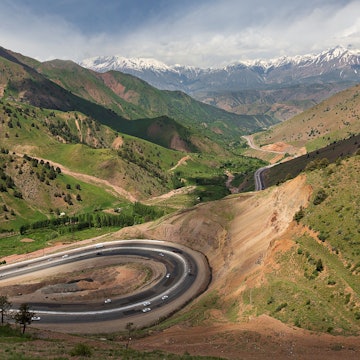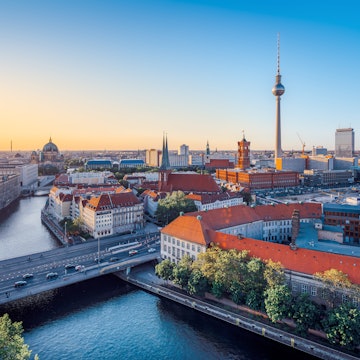

Castelo de São Jorge, Lisbon. kavalenkava/Shutterstock
No European city is quite like Lisbon. The Portuguese capital’s crumbling pastel paintwork, abundant azulejos (painted glazed tiles), hill-schlepping vintage funiculars and easy-going, old-world charm have lured me back countless times over the last two decades. For a stint, I called the city home, and although I now live in the Algarve, I still regularly hop on the train to continue my Lisbon love affair.
Spend a weekend roaming some of Lisbon’s seven hills, and you’ll witness the city at its atmospheric best. Sure, you might not see everything there is to do, but it will serve as an excellent introduction that will leave you smitten. Here’s my tried-and-tested three-day Lisbon itinerary that blends the big hitters with some surprises and seriously good meals.
When to arrive: Arrive on Thursday night or first thing Friday to enjoy three full days. Friday is a better long weekend addition as many attractions close on Monday. The exception is if you plan to visit Sintra’s palaces – then I’d suggest adding an extra day (Monday) when they will be slightly quieter.
How to get from the airport: Lisbon Airport is connected to the modern and efficient metro (Red Line), which will bring you downtown in around 30 minutes, including a transfer, for €1.85 (US$2.10). Taxis, Bolt, and Uber aren’t overly expensive, but with traffic, they also aren’t always quicker.
Getting around town: If you’re able, walking is the best way to explore Lisbon’s districts, even with the hills. Use Carris buses and trams to transit between neighborhoods so you don’t lose the views underground. Purchase and top up a Navegante card (or Lisboa card; see below) at the airport for the best fares. Avoid the tuk-tuks that have clogged the streets in recent years; they’re inauthentic and not overly appreciated by residents.
Where to stay: I’d suggest skipping Airbnb for a weekend visit both for convenience and due to Lisbon’s housing crisis. As Janelas Verdes, on the edge of laid-back Alcântara (my former neighborhood), is one of my favorite boutique boltholes with river-view terraces. Wallis São Bento, near Príncipe Real, is my go-to, no-frills weekend crash pad. Or choose the convent-converted Hotel Convento do Salvador to be amongst all of Alfama’s allure.
What to pack: Comfy shoes. Lisbon’s hills and cobblestones are a workout and far from heel-friendly. At any time of year, lightweight layers are a good idea – even in summer, the Atlantic can bring a cool breeze.
Lisboa Card: The 72-hour Lisboa Card (€62/US$70.55) includes public transportation and free entrance to many attractions. It will save you at least €15/US$17 if following this itinerary.




Day 1
Morning: Drop your bags and hop on the 15E Tram to Belém. This riverside district is home to exceptional architecture and one of Lisbon’s most legendary sweet treats: Pastéis de Belém. Ignore the lines for takeaway – it’s usually a brief wait for a table in the cavernous, blue-and-white azulejo-clad inside where there are hundreds of seats. Order a couple of the original pastéis de nata (custard tarts), sprinkle a little cinnamon on top, and sip a bica (espresso) for the tastiest experience.
How to spend the day: Begin your Belém sightseeing at the magnificent Mosteiro dos Jerónimos, whose former monks perfected the original pastel recipe. Book your ticket and time slot ahead to jump the long lines, and you’ll soon be marveling at the highly-embellished Manueline-style monastery – the cloisters steal the show. Continue to the waterfront to see the Padrão dos Descobrimentos, a towering monument to Portugal's key explorers during the colonizing "Age of Discovery" period, and the Torre de Belém, an ornate tower that's guarded the Tagus River since 1515. The lines for the latter can be sunburningly long, but the exterior is the main draw.
For a quick, organic lunch, head to ÚNICO, a social-impact cafe at the Centro Cultural de Belém, or hop on the tram to LX Factory, a former industrial area turned trendy hangout with a handful of international restaurants. After lunch, take the 15E back towards Cais do Sodré and walk to the Bica Funicular, an 1892-built vintage carriage. Ride the rails or climb the scenic staircase alongside it up to the Bairro Alto neighborhood. It’s then only a pretty 10-minute walk across Chiado via Praça Luís de Camões and Largo do Chiado, carpeted with some of Lisbon's most beautiful calçada portuguesa (patterned stone pavements), to Convento do Carmo. This 15th-century church was severely damaged in Lisbon’s 1755 earthquake, and the splintered columns and roofless interior remain a poignant reminder. Minutes away is the Miradouro de São Pedro de Alcântara, one of the city’s finest viewpoints – grab a vinho (wine) from the little kiosk (typical of Lisbon) and soak in the skyline and castle views.
Dinner: No visit to Lisbon is complete without hearing fado, Lisbon’s hauntingly melancholic musical genre born from the city’s working-class neighborhoods in the early 19th century. Casas do Fado (Fado Houses) are pricey and popular (Maria da Mouraria is my favorite), but for something different, book a pre-dinner ticket to Real Fado’s one-hour performances in Reservatório da Patriarcal, a decommissioned cistern underneath Jardim do Príncipe Real – the acoustics here always move me to tears.
For dinner, walk 10 minutes downhill to É Um Restaurante. Headed up by Chef Nuno Bergonse, the restaurant trains people experiencing homelessness and serves excellent contemporary takes on Portuguese classics – I highly recommend the massada de peixe, a fish and pasta stew, and the decadent chocolate mousse. If you forget to reserve a table, nearby Sr. Lisboa and Taberna Anti Dantas are equally delicious.
After dark: Amble towards pretty-at-night Rossio Station for a sweet cherry liqueur digestif at Ginjinha Sem Rival before walking (or riding the Gloria Funicular) back up the hill. For a classy nightcap, head to Gin Lovers, a chic bar in the interior courtyard of EmbaiXada, a palatial, Moorish-inspired shopping center. If you’re keen to keep going, join the crowds spilling onto the cobbles in Bairro Alto for an atmospheric, al fresco party. Start with one of Joao’s top-notch negronis at Janela d'Atalaia and then follow the road down – everyone ends up on the streets, so it doesn’t matter where you grab your drinks.




Day 2
Morning: If it wasn’t a late one, plan an early start in Alfama. Catching the morning’s golden light at bougainvillea-framed Miradouro de Santa Luzia, with views across the higgledy-piggledy russet rooftops and river, is my favorite way to start a Lisbon day. There’s a small kiosk nearby serving coffee and cakes from 9am or head to Quase Café for an earlier pancake brunch. If you want to ride the famous vintage Tram 28E, do so before breakfast to avoid the inevitable crowds.
How to spend the day: Alfama is Lisbon’s oldest neighborhood and survived the earthquake relatively unscathed. Start at the top with a visit to hill-crowing Castelo de São Jorge. After walking atop the Moorish-built crenelated walls for sweeping city views, descend back to the labyrinth that is Alfama and amble aimlessly amongst the pastel-hued streets below fluttering laundry. Grab an early lunch to avoid the rush. Pocket-sized Sardinha is the spot for a typical plate of grilled sardines, or snag a table on Largo do Chafariz at O Cartaxeiro and ask if arroz de pato (duck rice) is the prato do dia (dish of the day).
Continue to the Panteão Nacional (National Pantheon) and take a peek inside the hulking edifices – the best views are from the balconies – before browsing for unique vintage souvenirs at Feira da Ladra (Thieves Market), the Saturday flea market just beyond. If you’ve time, stop by the lesser-visited Mosteiro de São Vicente de Fora nearby for its rooftop views, frescoes and azulejo-lined hallways (I prefer it to Jerónimos and it’s far calmer).
Dinner: Clamber back up the hill to Graça for a swoon-worthy scenic sunset at the Miradouro da Graça. I always grab a beer from a nearby shop and enjoy it on the grassy slopes below before dinner. Book a table at Altar, a personality-packed restaurant with vintage knickknack adorning the walls, and order a few plates to share. The plump, garlic-sauteed prawns, baked yet soft octopus, and slow-cooked Iberian pork never disappoint. Nearby Damas, with its ever-changing, wall-scrawled menu, is another winner.
After dark: End the evening with some live music and dancing. Bartô, a characterful basement bar located underneath a circus training school, is always lively, and there’s usually a salsa, bossa nova or jazz live band setting the soundtrack. Or head downhill to Casa Independente, a quirky cultural hub spread across multiple bohemian-decked rooms around an al fresco courtyard, which hosts an eclectic and energetic program of live DJs, drag shows and alternative bands.




Day 3
Morning: Head to the nearest historic cafe for a galão (latte) and some freshly baked pastries or, if you’re like me and can never decide between sweet or savory, a coconut-topped pão de deus stuffed with cheese and ham. Depending on where you’re staying, that could be Confeitaria Nacional near Rossio, Panificação Reunida de São Roque near Príncipe Real, and A Brasileira in Chiado. All are spectacular, storied and part of the Lojas com História program, traditional restaurants and shops in need of preservation.
How to spend the day: Take the 759 bus or a cab to the Museu Nacional do Azulejo. If you only visit one museum in the city, this is the one. The collection of azulejos is superb, spans centuries and features a range of designs, from traditional blue-and-white patterns to more vibrant majolica motifs. Most impressive is the 36m (118ft) panel painted with an image of pre-earthquake Lisbon and the building itself: a 16th-century convent complete with a charming cloister and chapel decked out in gold.
Take the bus back to Praça do Rossio for lunch at Casa do Alentejo (reservation advised). Hidden behind the bland exterior is an exquisite neo-Moorish home with a fountain-anchored, salmon-hued courtyard and palatial-style chandelier-decked dining rooms. Order provincial classics from the Alentejo like porco à alentejana com améijoas (Iberian pork with clams) or Sunday's delicious lunch special, ensopado de borrego (lamb stew). Admittedly, the decor slightly outshines the dishes.
Suitably stuffed, saunter down grand Rua Augusta, downtown Baixa’s main thoroughfare lined with touristy shops and restaurants, taking a quick detour to see the wrought-iron Elevador de Santa Justa lift constructed in 1902. The queues for a ride up are almost always ridiculous, but if you’re in luck, hop onboard. Back down, continue to the imposing Arco da Rua Augusta. For the best views of Praça do Comércio, Lisbon’s monumental waterfront square, climb to the top of the arch via the easily missed door to the left.
Dinner: For a quick pre-flight bite, walk to Time Out Market in Lisbon’s reimagined waterfront marketplace. Some of Portugal’s best chefs are invited to open stands here, raising the standard of a typical food hall.
However, if you have time, hop on the 20-minute ferry from Cais do Sodré to Cacilhas, sailing towards the towering statue of Cristo Rei. Seeing Lisbon glisten from across the river is indelible, and my preferred way to appreciate the panorama is from the canary-yellow tables on the pier outside Ponto Final. It’s the perfect finale to savor octopus salad and cod fritters, sip a chilled glass of vinho verde (a young, lightly sparkling wine), and start planning a longer return visit to Lisbon.
















